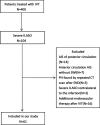Multiple hypointense vessels on susceptibility-weighted imaging predict early neurological deterioration in acute ischaemic stroke patients with severe intracranial large artery stenosis or occlusion receiving intravenous thrombolysis
- PMID: 32586972
- PMCID: PMC7804053
- DOI: 10.1136/svn-2020-000343
Multiple hypointense vessels on susceptibility-weighted imaging predict early neurological deterioration in acute ischaemic stroke patients with severe intracranial large artery stenosis or occlusion receiving intravenous thrombolysis
Abstract
Background and purpose: Early neurological deterioration (END) is a common feature in patients with acute ischaemic stroke (AIS) receiving thrombolysis. This study aimed to investigate whether the presence of multiple hypointense vessels (MHVs) on susceptibility-weighted imaging (SWI) could predict END in patients with the anterior circulation AIS treated with recombinant tissue plasminogen activator (r-tPA).
Methods: This was a retrospective study focusing on AIS patients suffering from symptomatic stenosis or occlusion of the middle cerebral artery or internal carotid artery with r-tPA treatment. We collected clinical variables and initial haematological and neuroimaging findings. MHVs were measured on SWI performed after intravenous thrombosis and were defined as the presence of a greater number of veins or veins of a larger diameter with greater signal loss on SWI than those of the contralesional haemisphere. The degree of hyperintensity of MHVs was classified into four grades: none, subtle, moderate and extensive. END was defined as an increase in the National Institutes of Health Stroke Scale score by 2 points during the first 48 hours after the onset of symptoms. Multivariate logistic regressions were conducted to investigate the predictors of END.
Results: The study included 61 patients (51 males and 10 females) with a mean age of 62.4±12.6 years. Thirty-five (57.4%) patients presented with MHVs: 8 (13.1%) were graded as subtle MHVs, while 23 (37.7%) and 4 (6.6%) were graded as moderate or extensive MHVs, respectively. Twenty patients (32.8%) presented with END. Logistic regression analysis showed that compared with patients without MHVs, moderate MHVs (adjusted OR 5.446, 95% CI 1.360 to 21.800; p=0.017) and extensive MHVs (adjusted OR 15.240, 95% CI 1.200 to 193.544; p=0.036) were significantly associated with END.
Conclusions: MHVs might be a useful predictor of END in AIS patients with symptomatic large artery stenosis or occlusion after r-tPA treatment.
Keywords: MRI; stroke.
© Author(s) (or their employer(s)) 2020. Re-use permitted under CC BY-NC. No commercial re-use. See rights and permissions. Published by BMJ.
Conflict of interest statement
Competing interests: None declared.
Figures


References
Publication types
MeSH terms
Substances
LinkOut - more resources
Full Text Sources
Medical
